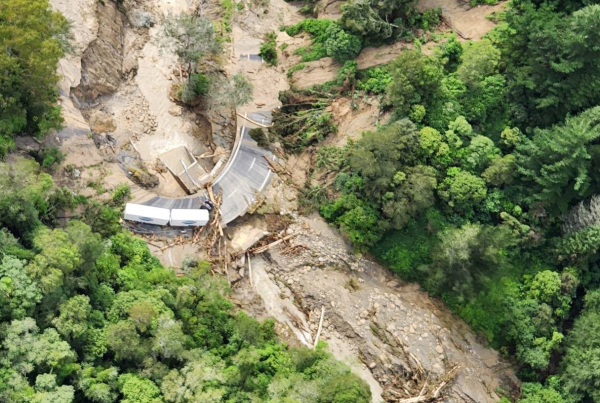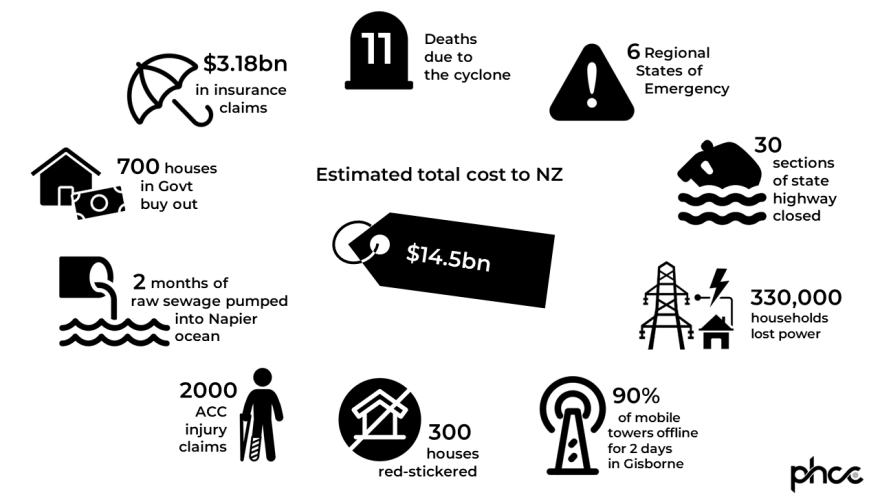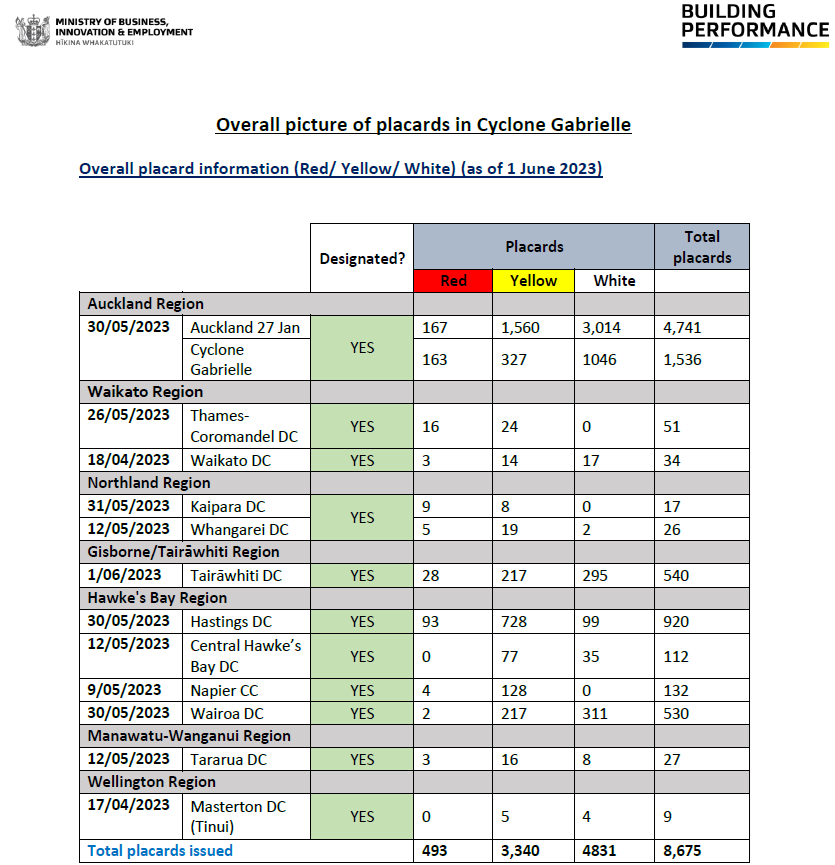Summary
Cyclone Gabrielle caused significant damage across northern and eastern regions of the North Island of Aotearoa New Zealand (NZ) in February 2023. It joined the list of NZ’s mass fatality events with 11 people losing their lives. The cost to the country is estimated to be up to $14.5 billion.
The large scale of this disaster would have justified an official national inquiry into the impact and response. But given this has not occurred, this Briefing summarises ‘by the numbers’ what is known about this disaster after six months. Our impression remains that NZ has a low level of resilience to this type of hazard event.
While we welcome the current government consultation on enhancing the resilience of NZ’s critical infrastructure, much more work is needed. In particular, both central and local government need to invest far more into making all infrastructure resilient to the impact of intensifying climate disruption.
There has been no national inquiry into the Cyclone Gabrielle disaster despite its major human well-being and economic impacts. Although there has been an inquiry into slash and land use,12 and an ongoing review of the Hawke’s Bay Civil Defence response, central government has not committed to a full examination of the Cyclone’s impact. This matters. Without a detailed examination of the ‘big picture', we cannot appropriately prepare for the next extreme weather event caused by climate disruption.
In this Briefing we aim to provide at least a brief overview of this major disaster by identifying key quantifiable impacts. We collate key statistics from media reports, government statements, Official Information Act Requests, and data provided by private companies.
Graphic showing some of the impacts of Cyclone Gabrielle covered in this Briefing.
Many regions impacted
A National State of Emergency was declared on 14 February, applying to the six regions most impacted by the cyclone: Northland, Auckland, Tairāwhiti, Bay of Plenty, Waikato, Hawke's Bay and Tararua District . This was only the third time in NZ history the Government has declared a National State of Emergency. It was ended in Northland, Auckland, Waikato and Tararua on 3 March, and Hawke’s Bay and Tairāwhiti on 14 March.
The high human and economic cost
Cyclone Gabrielle joined the list of NZ’s mass fatality events with 11 people losing their lives.3 Nearly 2000 people were injured during the cyclone according to ACC claims data (mainly soft tissue injuries – but also more serious fractures and concussions (see Appendix, Table A1). Some of these injuries, such as concussion, can result in months of poor health. These reported injuries do not take account of the mental stress faced by people with damaged or written off homes and livelihoods.
The Treasury has estimated the economic cost of this cyclone could be up to $14.5 billion.4 But this estimate could increase as initial repair work gets washed away by ongoing weather events. The cost estimates for Auckland have recently risen taking into account the need for resilient infrastructure.5
We know low-income and disadvantaged households suffer disproportionately from the impact of flooding and natural disasters which exacerbate poverty and inequities. These households often live in low-cost housing rentals in areas prone to floods and without the income to pay for insurance.6 Vulnerable groups include recent migrants, the elderly, people with disabilities and Māori. Of the almost 800 marae situated across Aotearoa, 80 percent are built on low-lying coastal land or flood-prone rivers7 and Māori are expected to face unique impacts from risks to sites of cultural significance.8
Major damage to housing
More than 300 houses were red-placarded (stickered) following Cyclone Gabrielle, with two-thirds of these houses in Auckland, according to data provided by MBIE (see Appendix Table A2). To date, some 700 properties at risk of future severe weather damage have received Government and council buyout offers.9
The Insurance Council of NZ says the Auckland Anniversary Weekend floods and Cyclone Gabrielle combined have resulted in more than 100,000 claims with an estimated cost to date of over $3.18 billion. New research estimates that 12% of New Zealand's housing value is in flood hazard areas.10
Extensive damage to roads
When the National State of Emergency was declared on 14 February, more than 30 sections of state highway were completely closed to traffic, according to data provided by transport agency Waka Kotahi (supplied 21 June 2023). This included a significant proportion of the state highways serving Northland, Auckland, Coromandel, Manawatu, the Central Plateau, Tairāwhiti and Hawkes’ Bay. State Highway 2 between Wairoa and Napier was the longest State Highway closure resulting from Cyclone Gabrielle. Access was restored three months post-cyclone following the completion of a single-lane bailey bridge, meaning work is still needed on a completely new bridge.
Widespread loss of electrical power
The five lines companies covering Northland, Auckland, Gisborne/Wairoa, Hawkes’ Bay and Taupo/Rotorua reported to us that 332,000 households lost power during the storm with 200,000 without power at the peak. According to correspondence from Northpower, which covers Northland but not the Far North, it was “the most significant event in staff memory” (supplied, 28 May 2023). Electricity providers we contacted were at pains to point out there has been a lot done to strengthen the resilience of the network. Based on the numbers provided, 60% of the customers disconnected were reconnected within minutes to a day. The 1% who were without power longer than two weeks were mostly in areas where major damage impeded access for repair crews.
Extensive loss of cellphone connectivity
The breaks in power caused another problem as thousands of people lost cellphone coverage and landlines, and EFTPOS went offline. The NZ Telecommunications Forum activated its Emergency Forum the weekend before the cyclone hit. The damage wasn’t to the mobile towers but to the power sources needed to run them. Only two cell phone towers out of more than 1600 in the main regions were actually damaged by the storm. “More than 660 mobile towers were knocked offline nationwide, but actual damage to the cell sites was minimal,” the Forum reported in a statement. “[…]in fact, 96 hours after we started our response work more than 90% of the towers were back online”.11
According to the Forum, 20% of towers were offline in affected regions on the 14 February. However in the worst hit region of Tairāwhiti about 90% of mobile towers were offline over the 14-15 February period.12
While emergency calls were able to be connected across most of the networks, there were instances where 111 calls were unable to be logged.13 Academics have questioned about whether communications systems vulnerable to single points of failure are “fit for purpose”.14
Major water infrastructure damage
Water infrastructure groaned under the impact of the cyclone, as detailed in a previous Briefing.15 Water supply damage in the North Island resulted in at least eight boil water notices, lasting an average of 19 days (ranging from five to 45 days) for the seven notices with complete data. Some wastewater plants were inundated including Napier’s which meant raw sewage was pumped into the sea for two months while repairs were underway.15
In summary, it is clear that New Zealand is lacking resilient infrastructure, making us particularly vulnerable to climate change super-charged storms (and various other types of disaster events). Cyclone Gabrielle laid this deficiency out in sharp relief leaving many communities devastated. The Government announced $6 billion for a National Resilience Plan in this year’s Budget with $100 million for a new infrastructure delivery agency.16It is also consulting on options for delivering a more resilient critical infrastructure system.17 Nevertheless, there is still an urgent need for both central and local government to strengthen infrastructure while planning for more disruptive weather events. The impetus for this critical long-term thinking should not be lost through the election cycle and any potential change of government.
What’s new in this Briefing
- Six months on we detail the very widespread and severe disruption to NZ society and infrastructure from Cyclone Gabrielle.
- We re-iterate our concern that such a major disaster has not triggered a national official inquiry into the impact and response to help guide systematic improvements in resilience.
Implications for public health policy and practice
- Protecting public health is a critical component of disaster preparedness and is becoming more important with the intensifying impact of climate disruption.
- Much greater investment is needed by central and local government into building more resilient infrastructure.
Author details
Professor Nick Wilson, Adele Broadbent & Dr John Kerr. All authors are based at the Public Health Communication Centre and Department of Public Health, University of Otago, Wellington.
Appendix: Additional findings on Cyclone Gabrielle impact and response
Flood protection barriers breached
Hawkes’ Bay Regional Council (HBRC) has commissioned an independent review looking at how its flood protection schemes withstood the cyclone. Gabrielle caused breached stopbanks in 30 places in the region. This was mostly on the Tūtaekurī and Ngaruroro Rivers between Napier and Hastings, and also the Waipawa and Wairoa Rivers.18 This region’s stopbanks seem worst hit, although rivers breached banks throughout the regions. Potentially the HBRC Review will add to informed discussions about the value investing in managed retreat of housing from flood plains rather than relying on such stopbanks.19
Warnings from Metservice
MetService’s tropical cyclone specialists first raised the potential of a tropical cyclone developing in the Coral Sea ten days ahead of the cyclone’s impact on NZ. From 9 February Metservice was issuing severe weather watches followed on the 11 February some areas being upgraded to Orange Warnings with the first red warnings issued that afternoon.20 This seems to us an impressive performance by MetService and a tribute to modern meteorological science and modelling.
Table A1: ACC data on accepted Cyclone Gabrielle related claims by the most prevalent primary injury diagnosis, as provided by ACC on 8 June 2023)
|
Primary injury diagnosis
|
New claims
|
Percent
|
|
Soft tissue injury
|
1,504
|
77.4%
|
|
Laceration / puncture / sting
|
245
|
12.6%
|
|
Fracture / dislocation
|
55
|
2.8%
|
|
Dental injury
|
22
|
1.1%
|
|
Foreign body eg, in eye
|
22
|
1.1%
|
|
Concussion
|
8
|
0.4%
|
|
Pain syndromes
|
5
|
0.3%
|
|
Burns
|
4
|
0.2%
|
|
Other / Unknown
|
78
|
4.0%
|
|
Total
|
1,943
|
100.0%
|
Table A2: MBIE figures on placarded (‘red stickered’) houses throughout NZ. Total red placard houses excluding Auckland 27 Jan floods: 326 houses.




